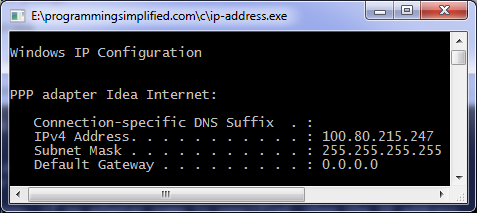#include<stdlib.h>
int main()
{
system("C:\\Windows\\System32\\ipconfig");
return 0;
}

int main()
{
system("C:\\Windows\\System32\\ipconfig");
return 0;
}

great place for C programmers


/* Write a C program to illustrate the concept of unions*/#include <stdio.h> #include <conio.h>
/* Write a C program to illustrate the operations of singly linked list */#include <stdio.h> #include <stdlib.h> #include <conio.h> #include <string.h> #define MAX 30
/* Write a C program to implement stack. Stack is a LIFO data strcuture * * LIFO - Last in First Out * * Perform PUSH(insert operation), POP(Delete operation) and Display stack */#include <stdio.h> #include <conio.h> #define MAXSIZE 5
#include<stdio.h>
int main( void ){
int year = 2012;
if( year % 4 == 0 && year % 100 != 0 ) {
printf("Leap Year..\n");
}else if (year % 4 == 0 && year % 400 == 0 ){
printf("Leap Year..\n");
}else{
printf("Not Leap Year..\n");
}
return 0;
}
#include<stdio.h>
int main( void ){
int year = 2012;
if(( year % 4 == 0 && year % 100 != 0 ) || (year % 4 == 0 && year % 400 == 0 )){
printf("Leap Year..\n");
}else{
printf("Not Leap Year..\n");
}
return 0;
}
printf("Hello, World! \n");
/0. For example:"c string tutorial"

chartype.char s[5];

// inline_functions_macro.c
#include <stdio.h>
#include <conio.h>
#define toupper(a) ((a) >= 'a' && ((a) <= 'z') ? ((a)-('a'-'A')):(a))
int main() {
char ch;
printf("Enter a character: ");
ch = toupper( getc(stdin) );
printf( "%c", ch );
}
Sample Input: xyz Sample Output: Z
// inline_functions_inline.cpp
#include <stdio.h>
#include <conio.h>
inline char toupper( char a ) {
return ((a >= 'a' && a <= 'z') ? a-('a'-'A') : a );
}
int main() {
printf("Enter a character: ");
char ch = toupper( getc(stdin) );
printf( "%c", ch );
}
Sample Input: a Sample Output: A